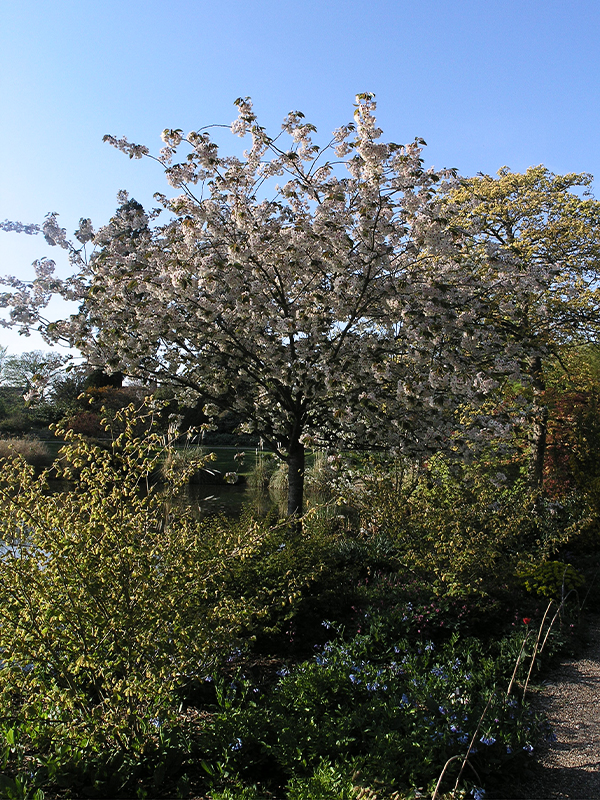
Woody > Prunus > Prunus serrulata > Prunus serrulata 'Ukon'
Prunus serrulata
'Ukon'
Ukon Village Cherry
Origin: From Japan. The origin of most Sato-Zakura (domestic cherries) is unknown
Mike's
Opinion


"
A unique and stunning cultivar that has much more landscape value than the rest of the Sato–Zakura group, due to its ability to withstand most soils and weather conditions, and of course it’s uniquely coloured flowers and vibrant autumn colour. Since most of its landscape value comes from its appearance, I’d recommend P. serrulata ‘Ukon’ to be used mostly for enhancing the appeal of a rural area garden, or possibly the centerpiece of a park or square. Although it’s becoming popular as a street tree, this cultivar has much more value than to be momentarily glanced at during a red light.
Michael Pascoe, NDP., ODH., CLT., MSc. (Plant Conservation)
"
| Family |
| Rosaceae |
| Genus |
| Prunus |
| Species |
| serrulata |
| Cultivar |
| 'Ukon' |
| Category |
| Woody |
| Type |
| Tree (deciduous) |
| Pronunciation |
| USDA Hardiness Zone |
| 5 - 8 |
| Canadian Hardiness Zone |
| 4a - 8a |
| RHS Hardiness Zone |
| H7 - H4 |
| Temperature (°C) |
| (-32) - (-7) |
| Temperature (°F) |
| (-25) - 20 |
| Height |
| 5-8 m |
| Spread |
| 7-10 m |
Photographs
Description and Growing Information
Flowering Period
| General Description |
| A medium sized tree, wide spreading crown with greenish yellow flowers. Bark is light brown and foliage is dull brown and transitions to red/orange leaves in autumn. |
| Landscape |
| A low maintenance tree often used for its unique cream coloured flowers and autumn colour. Can withstand full sunlight and is better off in urban location, although it’s used commonly as a street tree in Japan. Can grow in various soils and only requires annual to bi-annual pruning. |
| Cultivation |
| Prefers well drained, moist soils and can withstand many different soils and pH levels. Achieves maximum growth in full sun and pH levels between 6-7, in loam soil. |
| Shape |
| Broad vase shape spreading and eventually weeping with age. |
| Growth |
| Medium |
| ID Characteristic |
| Unlike most of its species it has creamy-yellowish coloured flowers. Its leaves are originally brown-coppery coloured, but then go a deep green, then red and orange in the autumn. |
| Pests |
| Known to be sustainable to disease, but may suffer from silver leaf or blossom wilt. Known pests are caterpillars and scale insects. Plum Pox: Symptoms may be confused with other diseases/disorders such as nutrient deficiencies or pesticide injuries. PPV symptoms can occur on leaves, flowers and/or fruit. Faint yellow rings or lines may be found on the leaves. PPV generally does not cause plant mortality however, can reduce the plant productivity and longevity. How to Reduce the Spread and Impact of PPV: 1. Propagate vulnerable Prunus trees and shrubs outside of the affected area a. Isolation is important to protect clean plants from future spread of the disease. b. Propagating and growing vulnerable plants away from the virus-infected area reduce the likelihood of the disease spreading any further. This should be as far away from the quarantined area and any potential sources of the virus. 2. Propagate Prunus plants with virus-free Budwood and Rootstock from virus tested mother trees a. This eliminates the propagation link for viral diseases. 3. Inspect vulnerable Prunus for symptoms a. All Prunus shrubs and trees should be visually inspected for symptoms at lease twice per year and conducted by trained personnel familiar with the virus. b. Any plants found to be infected should not be moved or sold and must be reported to the Canadian Food Inspection Agency immediately. c. Inspections should not be conducted in periods of hot weather (temperatures over 30˚C). 4. Manage aphid vectors a. Aphids are extremely attracted to suckers (vegetative shoots at the base of the tree), these should be removed to avoid aphid colonization, feeding or migration. 5. Plant tolerant and resistant varieties a. When available, grow plum pox tolerant or resistant Prunus varieties. |
| Habitat |
| Horticultural origin. |
| Bark/Stem Description |
| Has smooth bark with distinct horizontal lenticels. Bark is a lighter, “chestnut” brown. |
| Flower/Leaf Bud Description |
| Long narrow buds, arranged alternately along branch, in clusters of 2-5 at the end, approx. 10-15 cm long. |
| Leaf Description |
| Alternately arranged, simple, ovate-lanceolate leaves, ranging 5-13 cm in length and 3-6 cm in width. |
| Flower Description |
| Semi-double to double weeping flowers, bloom a creamy-yellow colour in late April. Approx. 4cm diameter |
| Fruit Description |
| Medium sized globose black drupe 8-10 mm diameter. Ripe in late summer early autumn. |
| Colour Description |
| Foliage begins a dull brown in the spring and summer then transitions into green then reds and oranges for the autumn. The bark is a bronze/brown and the flowers are a distinct cream colour, unlike any other cultivars of P. serrulata. |
| Texture Description |
| A medium textured tree. Noticeably smooth bark, other than lenticels. |
| Notable Specimens |
| University of British Colombia Botanical Garden, Vancouver, British Colombia. |
| Propagation |
| May occur through bottom heated softwood cuttings, but is assured through budding in early spring or sometimes even grafted on P. avium. (Mazzard Cherry). |
References
Kuitert, Wybe, 'Japanese flowering cherries', Dirr, Michael. 'Manual of woody landscape plants: their identification, ornamental characteristics, culture, propagation and uses'

